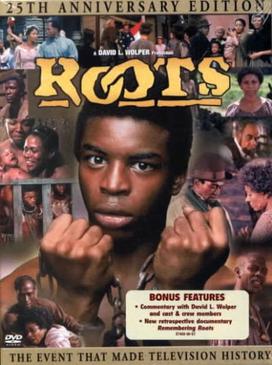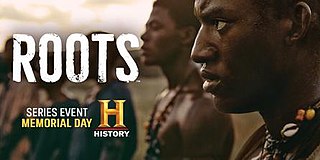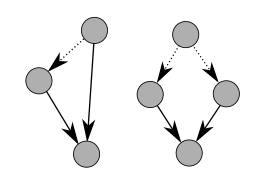
A hoax is a widely publicized falsehood so fashioned as to invite reflexive, unthinking acceptance by the greatest number of people of the most varied social identities and of the highest possible social pretensions to gull its victims into putting up the highest possible social currency in support of the hoax.

Alexander Murray Palmer Haley was an American writer and the author of the 1976 book Roots: The Saga of an American Family. ABC adapted the book as a television miniseries of the same name and aired it in 1977 to a record-breaking audience of 130 million viewers. In the United States, the book and miniseries raised the public awareness of black American history and inspired a broad interest in genealogy and family history.

The Mandinka or Malinke are a West African ethnic group primarily found in southern Mali, the Gambia, southern Senegal and eastern Guinea. Numbering about 11 million, they are the largest subgroup of the Mandé peoples and one of the largest ethnic-linguistic groups in Africa. They speak the Manding languages in the Mande language family, which are a lingua franca in much of West Africa. Virtually all of Mandinka people are adherent to Islam, mostly based on the Maliki jurisprudence. They are predominantly subsistence farmers and live in rural villages. Their largest urban center is Bamako, the capital of Mali.

Kunta Kinteh Island, formerly called James Island and St Andrew's Island, is an island in the Gambia River, 30 km (19 mi) from the river mouth and near Juffureh in the Republic of the Gambia. Fort James is located on the island. It is less than 3.2 km from Albreda on the river's northern bank. As an important historical site in the West African slave trade, it is listed as a UNESCO World Heritage Site, together with related sites including a ruined Portuguese chapel and a colonial warehouse in Albreda, the Maurel Frères Building in Juffureh, and Fort Bullen and Six-Gun Battery, which are located at the mouth of the Gambia River.

Roots is a 1977 American television miniseries based on Alex Haley's 1976 novel Roots: The Saga of an American Family, set during and after the era of slavery in the United States. The series first aired on ABC in January 1977 over eight consecutive nights.

Kunta Kinte is a fictional character in the 1976 novel Roots: The Saga of an American Family by American author Alex Haley. Kunta Kinte was based on one of Haley's ancestors, a Gambian man who was born around 1750, enslaved, and taken to America where he died around 1822. Haley said that his account of Kunta's life in Roots is a mixture of fact and fiction.

The Niger uranium forgeries were forged documents initially released in 2001 by SISMI, which seem to depict an attempt made by Saddam Hussein in Iraq to purchase yellowcake uranium powder from Niger during the Iraq disarmament crisis. On the basis of these documents and other indicators, the governments of the United States and the United Kingdom asserted that Iraq violated United Nations sanctions against Iraq by attempting to procure nuclear material for the purpose of creating weapons of mass destruction.

Roots: The Saga of an American Family is a 1976 novel written by Alex Haley. It tells the story of Kunta Kinte, an 18th-century African, captured as an adolescent, sold into slavery in Africa, and transported to North America; it follows his life and the lives of his descendants in the United States down to Haley. The release of the novel, combined with its hugely popular television adaptation, Roots (1977), led to a cultural sensation in the United States. The novel spent forty-six weeks on The New York Times Best Seller List, including twenty-two weeks at number one. The last seven chapters of the novel were later adapted in the form of a second miniseries, Roots: The Next Generations (1979). It stimulated interest in African American genealogy and an appreciation for African American history.

Albreda is a historic settlement in the Gambia on the north bank of the Gambia River, variously described as a 'trading post' or a 'slave fort'. It is located near Jufureh in the North Bank Division and an arch stands on the beach connecting the two places. As of 2008, it has an estimated population of 1,776.

Islam is the major religion in the Gambia, representing 97% of the 2 million population, with the first Muslim communities in the country arriving in 11th century. Islam has therefore had an influence on the Gambia throughout history, and continues to impact its culture, society and politics. The majority of The Gambia's Muslims are Sunni belonging to the Maliki school of jurisprudence, influenced with Sufism. There is a smaller Shiite community, largely stemming from Lebanese and Arab migration. The Ahmadiyya movement is also present. Other religious societies exist in the country, including Catholics, Protestants, Hindus and Traditional African religions.

The reliability of Wikipedia and its user-generated editing model, particularly its English-language edition, has been questioned and tested. Wikipedia is written and edited by volunteer editors who generate online content with the editorial oversight of other volunteer editors via community-generated policies and guidelines. The reliability of the project has been tested statistically through comparative review, analysis of the historical patterns, and strengths and weaknesses inherent in its editing process. The online encyclopedia has been criticized for its factual unreliability, principally regarding its content, presentation, and editorial processes. Studies and surveys attempting to gauge the reliability of Wikipedia have mixed results. Wikipedia's reliability was frequently criticized in the 2000s but has been improved; it has been generally praised in the late 2010s and early 2020s.

Roots: The Next Generations is an American television miniseries based on the last seven chapters of Alex Haley's 1976 novel Roots: The Saga of an American Family. First aired on ABC in February 1979, it is a sequel to the 1977 Roots miniseries, tracing the lives of Kunta Kinte's descendants in Henning, Tennessee, from 1882 to 1967.
The tourism industry today in the Gambia started when a party of 300 Swedish tourists arrived in 1965. That pioneering trip was organised by a Swede named Bertil Harding together with the tour operators Vingresor. It was seen as an ideal place to escape the harsh winter months of Scandinavia where Europeans would enjoy not only sun, sand and beaches but also experience the excitement of a real African holiday. It also offered a new opening for an affordable holiday to increasing numbers of traveling Europeans.

In May 2005, an unregistered editor posted a hoax article onto Wikipedia about journalist John Seigenthaler. The article falsely stated that Seigenthaler had been a suspect in the assassinations of U.S. President John F. Kennedy and U.S. Attorney General Robert F. Kennedy.

On Wikipedia, vandalism is editing the project in an intentionally disruptive or malicious manner. Vandalism includes any addition, removal, or modification that is intentionally humorous, nonsensical, a hoax, offensive, libelous or degrading in any way.
Lord Ligonier was an 18th-century British slave ship built in New England that unloaded enslaved Africans in Annapolis, Maryland in 1767. The ship was made famous by Alex Haley's novel, Roots: The Saga of an American Family, in which it brought his ancestor, Kunta Kinte, from The Gambia to the colonial United States.

Jar'Edo Wens was a deliberately fictitious Wikipedia article which existed for almost 10 years before being spotted in November 2014 and deleted in March 2015. At the time, it was the longest-lasting hoax article discovered in the history of Wikipedia.

Roots is a 2016 American miniseries and a remake of the 1977 miniseries with the same name, based on Alex Haley's 1976 novel, Roots: The Saga of an American Family, which follows an African man who is shipped to North America as a slave and his descendants. It first aired on May 30, 2016 and stars Malachi Kirby, Forest Whitaker, Anna Paquin, Laurence Fishburne, Jonathan Rhys Meyers, Anika Noni Rose, T.I. and South African actress Nokuthula Ledwaba. It was produced on a budget of $50 million.
From 2012 to 2022, Zhemao, an editor of the Chinese Wikipedia, created over 200 interconnected articles about falsified aspects of medieval Russian history in one of Wikipedia's largest hoaxes. Combining research and fantasy, the articles were fictive embellishments on real entities, as Zhemao used machine translation to understand Russian-language sources and invented elaborate detail to fill gaps in the translation. She started this practice as early as 2010 on Chinese history topics, but turned to Russian history in 2012, and the political interactions of medieval Slavic states in particular. Many of her hoax articles were created to fill detail in her initial fabrications. Zhemao eluded detection for over a decade by obtaining the community's trust: faking a persona as a Russian history scholar, using sockpuppet accounts to feign support, and exploiting the community's good faith that her obscure sources matched the article content.


















